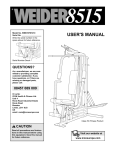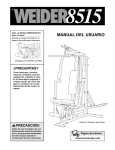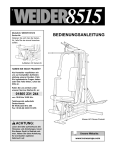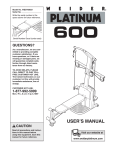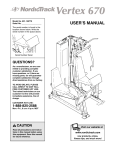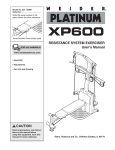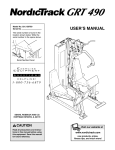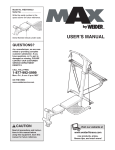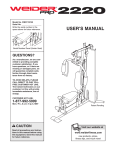Download Weider WESY29510 User`s manual
Transcript
Model No. WESY29510 Serial No. (Write the serial number in the space above for reference.) USER'S MANUAL Serial Number Decal QUESTIONS? As a manufacturer, we are committed to providing complete customer satisfaction. If you have questions, or if there are missing or damaged parts, we will guarantee complete satisfaction through direct assistance from our factory. TO AVOID UNNECESSARY DELAYS, PLEASE CALL DIRECT TO OUR TOLL-FREE CUSTOMER HOT LINE. The trained technicians on our customer hot line will provide immediate assistance, free of charge to you. CUSTOMER HOT LINE: 1-800-999-3756 Mon.–Fri., 6 a.m.–6 p.m. MST CAUTION Read all precautions and instructions in this manual before using this equipment. Save this manual for future reference. Visit our website at www.weiderfitness.com new products, prizes, fitness tips, and much more! TABLE OF CONTENTS IMPORTANT PRECAUTIONS . . . . . . . . . . . . . . . . . . . . . . . . . . . . . . . . . . . . . . . . . . . . . . . . . . . . . . . . . . . . .3 BEFORE YOU BEGIN . . . . . . . . . . . . . . . . . . . . . . . . . . . . . . . . . . . . . . . . . . . . . . . . . . . . . . . . . . . . . . . . . . .4 ASSEMBLY . . . . . . . . . . . . . . . . . . . . . . . . . . . . . . . . . . . . . . . . . . . . . . . . . . . . . . . . . . . . . . . . . . . . . . . . . . .5 ADJUSTMENTS . . . . . . . . . . . . . . . . . . . . . . . . . . . . . . . . . . . . . . . . . . . . . . . . . . . . . . . . . . . . . . . . . . . . . . .17 WEIGHT RESISTANCE CHART . . . . . . . . . . . . . . . . . . . . . . . . . . . . . . . . . . . . . . . . . . . . . . . . . . . . . . . . . . .19 TROUBLE-SHOOTING AND MAINTENANCE . . . . . . . . . . . . . . . . . . . . . . . . . . . . . . . . . . . . . . . . . . . . . . . .20 CABLE DIAGRAM . . . . . . . . . . . . . . . . . . . . . . . . . . . . . . . . . . . . . . . . . . . . . . . . . . . . . . . . . . . . . . . . . . . . .21 EXERCISE GUIDELINES . . . . . . . . . . . . . . . . . . . . . . . . . . . . . . . . . . . . . . . . . . . . . . . . . . . . . . . . . . . . . . . .22 ORDERING REPLACEMENT PARTS . . . . . . . . . . . . . . . . . . . . . . . . . . . . . . . . . . . . . . . . . . . . . . . .Back Cover LIMITED WARRANTY . . . . . . . . . . . . . . . . . . . . . . . . . . . . . . . . . . . . . . . . . . . . . . . . . . . . . . . . . . .Back Cover Note: A PART IDENTIFICATION CHART and a PART LIST/EXPLODED DRAWING are attached in the center of this manual. Remove the PART IDENTIFICATION CHART and PART LIST/EXPLODED DRAWING before beginning assembly. WEIDER is a registered trademark of ICON Health & Fitness, Inc. 2 IMPORTANT PRECAUTIONS WARNING : To reduce the risk of serious injury, read the following important precautions before using the weight system. 1. Read all instructions in this manual and in the accompanying literature before using the weight system. 13. Make sure that the cables remain on the pulleys at all times. If the cables bind while you are exercising, stop immediately and make sure that the cables are on all of the pulleys. 2. It is the responsibility of the owner to ensure that all users of the weight system are adequately informed of all precautions. 3. The weight system is intended for home use only. Do not use the weight system in any commercial, rental, or institutional setting. 14. Learn the correct technique before using the punching bag or speed bag. Always wear the proper protective gear for your hands and wrists while using either bag. Using either bag without the correct technique or the proper gear could result in serious injury. 4. Use the weight system only on a level surface. Cover the floor beneath the weight system to protect the floor. 15. If you feel pain or dizziness at any time while exercising, stop immediately and begin cooling down. 5. Make sure all parts are properly tightened each time you use the weight system. Replace any worn parts immediately. 16. The decals shown below have been placed on the weight system in the locations shown on page 4. If a decal is missing or illegible, call our toll-free Customer Hot Line at 1-800-999-3756 and order a free replacement decal. Apply the decal in the location shown. 6. Keep children under 12 and pets away from the weight system at all times. 7. Keep hands and feet away from moving parts. 8. Always wear athletic shoes for foot protection. Keep hands and fingers clear of this area. 9. The weight system is designed to support a a maximum user weight of 250 pounds. Decal 2 10. Always stand on a foot plate when performing an exercise that could cause the weight system to tip. 11. Never release the press arm, butterfly arms, leg lever, lat bar, or nylon strap while weights are raised. The weights will fall with great force. Decal 1 12. Always disconnect the lat bar from the weight system when performing an exercise that does not use the lat bar. WARNING: Before beginning this or any exercise program, consult your physician. This is especially important for persons over the age of 35 or persons with pre-existing health problems. Read all instructions before using. ICON assumes no responsibility for personal injury or property damage sustained by or through the use of this product. 3 BEFORE YOU BEGIN Thank you for selecting the versatile WEIDER® SPARRING SYSTEM weight system. The SPARRING SYSTEM offers a selection of weight stations designed to develop every major muscle group of the body. Whether your goal is to tone your body, build dramatic muscle size and strength, or improve your cardiovascular system, the SPARRING SYSTEM will help you to achieve the specific results you want. Department toll-free at 1-800-999-3756, Monday through Friday, 6 a.m. until 6 p.m. Mountain Time (excluding holidays). To help us assist you, please note the product model number and serial number before calling. The model number is WESY29510. The serial number can be found on a decal attached to the weight system (see the front cover of this manual). Before reading further, please review the drawing below and familiarize yourself with the parts that are labeled. For your benefit, read this manual carefully before using the weight system. If you have additional questions, please call our Customer Service ASSEMBLED DIMENSIONS: Height: 76 in. Width: 37 in. Length: 48 in. Punching Bag High Pulley Station Lat Bar Speed Bag Butterfly Arms Decal 1 Backrest Left Side Rear Upright Right Side Seat Weight Guide Decal 2 Press Arm Weight Stack Leg Lever Low Pulley Station Note: The terms “right side” and “left side” are determined relative to a person sitting on the seat; they do not correspond to right and left on the drawings in the manual. Foot Plate 4 ASSEMBLY Make sure you have the following tools: Make Assembly Easier for Yourself • Two adjustable wrenches Everything in this manual is designed to ensure that the weight system can be assembled successfully by anyone. Before beginning assembly, make sure to read the information on this page. This brief introduction will save you much more time than it takes to read it. • One standard screwdriver • One phillips screwdriver • One rubber mallet • You will also need grease or petroleum jelly, and a small amount of soapy water. Assembly Requires Two Persons Note: Assembly will be more convenient if you have a socket set, a set of open-end or closed-end wrenches, or a set of ratchet wrenches. For your convenience and safety, assemble the weight system with the help of another person. How to Identify Parts Set Aside Enough Time Due to the many features of the weight system, the assembly process will take a few hours. By setting aside plenty of time and by deciding to make the task enjoyable, assembly will go smoothly. You may want to assemble the weight system over a couple of evenings. To help you identify the small parts used in assembly, we have included a PART IDENTIFICATION CHART in the center of this manual. Place the chart on the floor and use it to easily identify parts during each assembly step. Note: Some small parts may have been pre-attached. If a part is not in the parts bag, check to see if it has been pre-attached. Select a Location for the Weight System How to Orient Parts Because of its weight and size, the weight system should be assembled in the location where it will be used. Make sure that there is enough room to walk around the weight system as you assemble it. As you assemble the weight system, make sure that all parts are oriented exactly as shown in the drawings. Tightening Parts How to Unpack the Box Tighten all parts as you assemble them, unless instructed to do otherwise. To make assembly as easy as possible, we have divided the assembly process into four stages. The parts needed for each stage are found in individual bags. Important: Wait until you begin each stage to open the parts bag for that stage. Place all parts of the weight system in a cleared area and remove the packing materials. Do not dispose of the packing materials until assembly is completed. Questions? If you have questions after reading the assembly instructions, please call our Customer Service Department at 1-800-999-3756. The Four Stages of the Assembly Process Frame Assembly—You will begin by assembling the base and the uprights that form the skeleton of the weight system. Cable Assembly—During this stage you will attach the cables and pulleys that connect the arms to the weights. Arm Assembly—During this stage you will assemble the arms and the leg lever. Seat Assembly—During the final stage you will assemble the seat and the backrest. 5 1 Frame Assembly 55 1. Before beginning assembly, be sure that you have read and understand the information in the box on page 5. 1 73 3 Hole 83 Press three 2” Square Inner Caps (55) into the ends of the Stabilizer (1) and the Base (2). Insert two 5/16” x 2 3/4” Carriage Bolts (66) up through the Stabilizer. Insert two 5/16” x 2 1/2” Carriage Bolts (65) up through the Base. 83 2 66 55 65 The Punching Bag (not shown) can be assembled on either side of the weight system. Orient the Stabilizer (1) so that the indicated hole is on the side of weight system that you want the Punching Bag to be on. Note: The assembly steps in this manual show the Punching Bag assembled on the right side of the weight system. 55 2 High Side of Bracket Holes Attach the Stabilizer (1) to the Base (2) with the Base Support Plate (3), two 5/16” x 2 3/4” Bolts (73), and two 5/16” Nylon Locknuts (83). Do not tighten the Nylon Locknuts yet. 9 5 2. Slide the Rear Upright (5) onto the 5/16” x 2 3/4” Carriage Bolts (66) in the Stabilizer (1). The high side of the bracket on the Rear Upright must be on the side shown. Hand tighten a 5/16” Nylon Locknut (83) onto each Carriage Bolt. Attach the Rear Upright (5) to the Base (2) with the Base Support Plate (3), two 5/16” x 2 3/4” Bolts (73), and two 5/16” Nylon Locknuts (83). 83 Tighten the 5/16” Nylon Locknuts (83) used in steps 1 and 2. 28 Set two Weight Bumpers (28) over the indicated holes in the bracket on the Base (2). Insert the two Weight Guides (9) into the holes in the bracket. Be sure that the holes in the Weight Guides are at the top, as shown. 3 73 66 2 6 1 83 3. Slide the nine Weights (22) onto the Weight Guides (9). Be sure that all of the Weights are turned so the large pin grooves are on the bottom of the Weights and on the front of the weight stack. 3 9 24 Lubricate Press the Weight Tube Bumper (27) into the end of the Weight Tube (26). Insert the Weight Tube into the stack of Weights (22). Be sure that the pins on the Weight Tube are resting in the pin grooves in the upper Weight. Pin 26 27 Lubricate the insides of the holes in the Top Weight (24). Slide the Top Weight onto the Weight Guides (9). Pin Groove 22 4. Press a 1” Square Inner Cap (53) into the Front Upright (4). 4 Slide the Front Upright (4) onto the 5/16” x 2 1/2” Carriage Bolts (65) in the Base (2). Hand tighten two 5/16” Nylon Locknuts (83) onto the Carriage Bolts. Do not tighten the Nylon Locknuts yet. 4 53 83 65 2 5. Press two 2” Square Inner Caps (55) into the ends of the Top Frame (10). Press a 1 3/4” Square Inner Cap (56) into each end of the crossbar on the Top Frame. Press two Round Inner Caps (59) into the top of the crossbar. 5 73 56 85 59 73 85 85 55 10 Attach the Top Frame (10) to the Front Upright (4) and the Rear Upright (5) with four 5/16” x 2 3/4” Bolts (73), four 5/16” Washers (85), and four 5/16” Nylon Locknuts (83). 56 55 Tighten the 5/16” Nylon Locknuts (83) used in steps 4 and 5. Crossbar 83 4 7 83 5 6. Attach the upper ends of the Weight Guides (9) to the Top Frame (10) with the 5/16” x 6” Bolt (91), two 1/2” x 3/4” Spacers (39), and a 5/16” Nylon Locknut (83). 6 91 39 10 See the inset drawing. Be sure that the Pulley Bracket (51) is in front of the right Weight Guide (9). 83 51 9 9 7 Arm Assembly Holes 13 7. Press a 1” x 7/8” Plastic Bushing (40) onto each welded spacer on the Press Frame (13). Slide the Press Frame into place on the Base (2). Note: This will be a tight fit. The Plastic Bushings should fit onto each end of the indicated tube in the Base. Be sure that the holes are on the indicated side of the Press Frame. 84 Welded Spacers 71 Lubricate 40 Lubricate the 3/8” x 8” Bolt (71). Attach the Press Frame (13) to the Base (2) with the Bolt and a 3/8” Nylon Locknut (84). Do not overtighten the Nylon Locknut; the Press Frame must be able to pivot freely. 2 8 8. Press a 1 3/4” Square Inner Cap (56) into the top of a Press Arm (14). Press a 1” Round Inner Cap (61) into the end of the handle on the Press Arm. Tube 56 61 Attach the Press Arm (14) to one side of the Press Frame (13) with two 5/16” x 2 1/2” Bolts (80) and two 5/16” Nylon Locknuts (83). 14 14 13 80 Assemble the other Press Arm (14) in the same manner. 83 9. Identify the Left Arm (11) and the Right Arm (12). Note the position of the welded bracket on each Arm. Arm identification is very important for step 10. 9 Welded Brackets 12 Press 1 3/4” Square Inner Caps (56) into the lower ends of the Left and Right Arms (11, 12). Wet the end of each Arm with soapy water, and slide a 10” Pad (62) onto each Arm. 62 11 56 62 56 8 10. Lubricate both axles on the Top Frame (10). 10 10 Bracket Slide the Right Arm (12) onto the right axle on the Top Frame (10). Note: Be careful not to confuse the Right Arm with the Left Arm (11); refer to step 9 to identify the Right Arm. Be sure that the upper end of the Right Arm is behind the indicated bracket on the Top Frame. Lubricate Axle 12 48 Place two 1” Retainers (48) on top of a 1” Round Cover Cap (49), as shown in the inset drawing. Be sure that the teeth on the Retainers bend toward the Cover Cap. Tap the Cover Cap and Retainers onto the right axle. 11 49 Attach the Left Arm (11) in the same manner. 10 48 49 11. Press four 1 1/2” x 2” Inner Caps (52) into the ends of the Punching Bag Arm (6) and the Speed Bag Arm (7). 11 84 86 52 Attach a 3/8” x 2” Eyebolt (64) to the Punching Bag Arm (6) with two 3/8” Washers (86) and a 3/8” Nylon Locknut (84). 86 64 6 7 52 52 52 12. Attach the Speed Bag Board (33) to the Speed Bag Arm (7) with four 3/8” x 1” Bolts (89) and four 3/8” Nylon Jamnuts (92). 12 92 7 33 89 9 89 13. Attach the Speed Bag Hook (32) to the Speed Bag Arm (7) with two #10 x 1” Bolts (88), two #10 x 2 1/2” Bolts (87), four #10 Washers (93), and four #10 Nylon Locknuts (63). 13 93 63 63 93 7 32 87 14. The Punching Bag Arm (6) and the Speed Bag Arm (7) can be adjusted to several heights. Hold the Punching Bag Arm at the desired height, and align the set of holes with a set of holes in the Rear Upright (5). Have a second person repeat this process with the Speed Bag Arm. Note: Make sure the Punching Bag Arm (6) is on the same side of the weight system as the hole in the Stabilizer (not shown); refer to step 1. The Punching Bag should hang so that the top is slightly higher than the user’s head. 88 87 14 8 6 7 95 84 Attach the Punching Bag Arm (6) and the Speed Bag Arm (7) to the Rear Upright (5) with two Large Support Plates (8), two 3/8” x 6” Bolts (90), two 3/8” Nylon Locknuts (84) and two Plastic Covers (95). 8 5 15 Cable Assembly 10 15. During steps 15 through 27, refer to the CABLE DIAGRAM on page 21 to verify proper cable routing. 84 Hook IMPORTANT: While assembling the cables, do not overtighten the bolts and nuts securing the pulleys. The pulleys must be able to turn freely. 45 Ball Locate the Long Cable (41). Route the Long Cable around a 3 1/2” Pulley (45). Attach the Pulley to the Top Frame (10) with a 3/8” x 3 3/4” Bolt (70) and a 3/8” Nylon Locknut (84). Be sure that the Cable is between the Pulley and the hook, and that the end of the Cable with the ball is on the indicated side of the hook. 41 70 16 Bracket 16. Wrap the Long Cable (41) around a “V”-Pulley (46). Attach the Pulley and a Long Cable Trap (43) to the indicated bracket on the Front Upright (4) with a 3/8” x 2 1/2” Bolt (79) and a 3/8” Nylon Locknut (84). Be sure that the Long Cable Trap is positioned to hold the Cable in place. 43 84 46 41 10 4 79 90 17. Route the Long Cable (41) around a “V”-Pulley (46). Attach the Pulley and a Long Cable Trap (43) to the bracket on the Left Arm (11) with a 3/8” x 2 1/2” Bolt (79) and a 3/8” Nylon Locknut (84). Be sure that the Cable is in the groove of the Pulley and that the Cable Trap is positioned to hold the Cable in place. 17 79 43 46 Bracket 41 11 84 18. Route the Long Cable (41) around a “V”-Pulley (46). Attach the Pulley and a Long Cable Trap (43) to the bracket on the Right Arm (12) with a 3/8” x 2 1/2” Bolt (79) and a 3/8” Nylon Locknut (84). Be sure that the Cable is in the groove of the Pulley and that the Cable Trap is positioned to hold the Cable in place. 18 79 43 46 12 Bracket 41 84 19. Route the Long Cable (41) around the 3 1/2” Pulley (45) attached to the Pulley Bracket (51). Be sure that the Cable is in the groove of the Pulley and that the Cable Trap (44) is turned to hold the Cable in place. Tighten the 3/8” Nylon Locknut (84). 19 51 41 45 44 Be sure that the 5/16” x 5” Bolt (not shown) is properly tightened and that the Pulley Bracket (51) can move freely. 84 20. Attach a 3 1/2” Pulley (45) and a Cable Trap (44) to the indicated hole in the Long “U”-Bracket (50) with a 3/8” x 2” Bolt (74) and a 3/8” Nylon Locknut (84). Be sure that the Cable Trap is inside the “U”-Bracket. Note: This may come pre-assembled. 20 41 45 Route the Long Cable (41) between the 3 1/2” Pulley (45) and the Cable Trap (44). Be sure that the Cable is in the groove of the Pulley and that the Cable and Pulley move smoothly. 44 74 50 11 84 21. Route the Long Cable (41) over a 3 1/2” Pulley (45). Attach the Pulley and a Cable Trap (44) to the bracket on the Top Frame (10) with a 3/8” x 2” Bolt (74) and the 3/8” Nylon Locknut (84). Be sure that the Cable is in the groove of the Pulley and that the Cable and Pulley move smoothly. 21 Bracket 10 84 45 44 74 41 22. Attach the Long Cable (41) to the Small “U”Bracket (25) with a 1/4” Nylon Locknut (82) and a 1/4” Washer (81). See the inset drawing. Do not overtighten the Nylon Locknut; it should be threaded onto the end of the Cable only two turns, as shown. 22 41 75 25 81 82 26 83 Attach the Small “U”-Bracket (25) to the Weight Tube (26) with the 5/16” x 1 3/4” Bolt (75) and a 5/16” Nylon Locknut (83). 41 25 82 23. Locate the Short Cable (42). Route the Short Cable under a Pro 3 1/2” Pulley (94). Attach the Pulley and the 5/8” x 9/16” Spacer (58) to the lower hole in the Press Frame (13) with a 3/8” x 3 3/4” Bolt (70), a 3/8” Washer (86), and a 3/8” Nylon Locknut (84). Be sure that the end of the Cable with the ball is on the indicated side of the Pulley. 23 84 94 Ball 86 58 42 24. Wrap the Short Cable (42) around a 3 1/2” Pulley (45). Attach the Pulley and a Cable Trap (44) to the lower hole in the Front Upright (4) with a 3/8” x 3 3/4” Bolt (70), a 3/8” Washer (86), and a 3/8” Nylon Jamnut (92). Be sure that the Cable Trap is turned to hold the Cable in place and that the Cable is routed around the Pulley as shown. 13 24 4 70 86 44 42 12 45 92 70 25. Wrap the Short Cable (42) around a 3 1/2” Pulley (45). Attach the Pulley and a Cable Trap (44) to the upper hole in the Press Frame (13) with a 3/8” x 3 1/2” Bolt (69), a 3/8” Washer (86), and a 3/8” Nylon Locknut (84). Be sure that the Cable Trap is turned to hold the Cable in place and that the Cable is routed around the Pulley as shown. 25 42 84 45 44 86 69 13 26. Wrap the Short Cable (42) around a 3 1/2” Pulley (45). Attach the Pulley and a Cable Trap (44) to the upper hole in the Front Upright (4) with a 3/8” x 3 3/4” Bolt (70), a 3/8” Washer (86), and a 3/8” Nylon Jamnut (92). Be sure that the Cable Trap is turned to hold the Cable in place and that the Cable is routed around the Pulley as shown. 26 4 70 86 44 45 92 42 27. Have a second person lift the Top Weight (24) off the stack of Weights (22). Attach the end of the Short Cable (42) to the Long “U”-Bracket (50) with a 1/4” Nylon Locknut (82) and a 1/4” Washer (81). See the inset drawing. Do not overtighten the Nylon Locknut; it should be threaded onto the end of the Cable so only two threads are showing above the Nylon Locknut. 27 82 50 81 42 24 22 82 50 13 42 28 Seat Assembly 4 21 28. Attach the Backrest (21) to the Front Upright (4) with two 1/4” x 2 1/2” Screws (72) and two 1/4” Washers (81). 72 81 72 81 29. Press a 1 1/2” Square Inner Cap (57) into the Seat Frame (15). 29 20 Insert the 1/4” x 2” Carriage Bolt (68) into the center hole in the Seat Plate (19). Attach the Seat Plate to the Seat (20) with two 1/4” x 3/4” Screws (67). 68 19 Insert the 1/4” x 2” Carriage Bolt (68) into the indicated hole in the Seat Frame (15). Tighten a 1/4” Nylon Locknut (82) with a 1/4” Washer (81) onto the Carriage Bolt. 57 67 15 82 Attach the other end of the Seat (20) to the Seat Frame (15) with a 1/4” Washer (81) and the 1/4” x 2” Screw (76). 30. Press a 1 1/2” Square Inner Cap (57) into the Leg Lever (16). 81 76 30 15 Lubricate the 5/16” x 2 1/4” Bolt (77). Attach the Leg Lever (16) to the Seat Frame (15) with the Bolt and a 5/16” Nylon Locknut (83). Do not overtighten the Nylon Locknut; the Leg Lever must be able to pivot freely. 83 Lubricate 77 16 64 86 Insert a 3/8” x 2” Eyebolt (64) into the Leg Lever (16) from the direction shown. Tighten a 3/8” Nylon Locknut (84) and a 3/8” Washer (86) onto the Eyebolt. 84 31. Rest the Seat Frame (15) on the indicated pin in the Front Upright (4). Attach the Seat Frame to the Front Upright with a 5/16” x 2 3/4” Carriage Bolt (66) and the Seat Knob (60). 31 57 66 15 60 4 14 Pin 32. Press four 3/4” Round Inner Caps (54) into the ends of the two Pad Tubes (17). 32 Insert one Pad Tube (17) into the Seat Frame (15). Slide a 5 1/2” Pad (18) onto each end of the Pad Tube. Insert the other Pad Tube (17) into the Leg Lever (16). Slide a 5 1/2” Pad (18) onto each end of the Pad Tube. 15 18 16 54 17 54 18 33. Attach the top of the Punching Bag (30) to the 3/8” x 2” Eyebolt (64) in the Punching Bag Arm (6) with a Cable Clip (38). Attach the bottom of the Punching Bag to the hole in the Stabilizer (1) with the Bungee Cord (29). 33 64 38 30 29 Hole 1 15 6 34. Slide the Speed Bag (31) onto the Speed Bag Hook (32). 34 32 31 35. Make sure that all parts have been properly tightened. The use of the remaining parts will be explained in ADJUSTMENTS, beginning on the following page. Before using the weight system, pull each cable a few times to be sure that the cables move smoothly over the pulleys. If one of the cables does not move smoothly, find and correct the problem. IMPORTANT: If the cables are not properly installed, they may be damaged when heavy weight is used. See the CABLE DIAGRAM on page 21 for proper cable routing. If there is any slack in the cables, you will need to remove it by tightening the cables; see TROUBLE-SHOOTING AND MAINTENANCE on page 20. 16 ADJUSTMENTS The instructions below describe how each part of the weight system can be adjusted. Refer to the exercise guide accompanying this manual to see how the weight system should be set up for each exercise. IMPORTANT: When attaching the lat bar or nylon strap, make sure that the attachments are in the correct starting position for the exercise to be performed. If there is any slack in the cables or chain as an exercise is performed, the effectiveness of the exercise will be reduced. CHANGING THE WEIGHT SETTING To change the weight setting of the weight stack, insert the Weight Pin (23) under the desired Weight (22). Be sure to insert the Weight Pin until the bent end of the Weight Pin is touching the Weights, and turn the bent end downward. The weight setting of the weight stack can be changed from 6.5 pounds to 119 pounds, in increments of 12.5 pounds. Note: Due to the cables and pulleys, the actual amount of resistance at each exercise station may vary from the weight setting. Use the WEIGHT RESISTANCE CHART on page 19 to find the actual amount of resistance at each weight station. 22 23 ATTACHING THE LAT BAR OR NYLON STRAP TO THE HIGH OR LOW PULLEY STATION Attach the Lat Bar (34) to the Long Cable (41) or Short Cable (not shown) with a Cable Clip (38). For some exercises, the Chain (37) should be attached between the Lat Bar and the Cable with two Cable Clips. Adjust the length of the Chain between the Lat Bar and the Cable so the Lat Bar is in the correct starting position for the exercise to be performed. 37 41 38 Note: The seat frame must be removed from the front upright before the Short Cable (not shown) is used. (See ATTACHING AND REMOVING THE SEAT, below.) 38 34 The Nylon Strap (not shown) can be attached in the same manner. ATTACHING AND REMOVING THE SEAT 15 66 Set the bracket on the Seat Frame (15) onto the indicated pin on the Front Upright (4). Attach the Seat Frame to the Front Upright with the 5/16” x 2 3/4” Carriage Bolt (66) and the Seat Knob (60). 20 60 13 4 16 For some exercises, the Seat (20) must be removed. First, be sure that the Chain (not shown) is not attached to the Leg Lever (16). Next, remove the Seat Knob (60) and the 5/16” x 2 3/4” Carriage Bolt (66) from the Seat Frame (15). Lift the Seat Frame off the Front Upright (4). Pin 17 ATTACHING THE LEG LEVER TO THE LOW PULLEY STATION To use the Leg Lever (16), the seat must be attached to the front upright (see ATTACHING AND REMOVING THE SEAT, on page 17). 38 16 64 Attach the Short Cable (42) to the 3/8” x 2” Eyebolt (64) with the Chain (37) and two Cable Clips (38). 37 42 38 ADJUSTING THE HEIGHT OF THE BAG ARMS 6 To adjust the height of the Punching Bag (30) or the Speed Bag (31), first remove both Bags from the weight system. Remove the two 5/16” x 5 3/4” Bolts (90), Large Support Plates (8), and 5/16” Nylon Locknuts (83) attaching the Punching Bag Arm (6) and the Speed Bag Arm (7) to the Rear Upright (5). Adjust the height of the Arms and reattach them to the Rear Upright with the Bolts, Support Plates, and Nylon Locknuts. Reattach the Bags to the Arms. Note: The Punching Bag should hang so that the top is slightly higher than the user’s head. 30 83 8 7 11 8 5 18 90 31 WEIGHT RESISTANCE CHART This chart shows the approximate weight resistance at each station. “Top” refers to the 6.5 lb. top weight. The other numbers refer to the 12.5 lb. weight plates. Weight resistance shown for the butterfly arm station is for each butterfly arm. WEIGHT PLATES PRESS ARM (lbs.) BUTTERFLY ARM (lbs.) LEG LEVER (lbs.) HIGH PULLEY (lbs.) LOW PULLEY (lbs.) Top 20 15 30 14 24 1 45 33 50 28 54 2 70 43 70 44 82 3 99 55 95 60 115 4 128 67 115 72 147 5 153 75 133 90 175 6 184 90 150 103 209 7 210 100 168 140 250 8 237 110 185 157 280 9 260 120 205 175 300 The actual resistance at each weight station may vary due to differences in individual weight plates, as well as friction between the cables, pulleys, and weight guides. 19 TROUBLE-SHOOTING AND MAINTENANCE Inspect and tighten all parts each time you use the weight system. Replace any worn parts immediately. The weight system can be cleaned using a damp cloth and mild non-abrasive detergent. Do not use solvents. TIGHTENING THE CABLES A Woven cable, the type of cable used on the weight system, can stretch slightly when it is first used. If there is slack in the cables before resistance is felt, the cables should be tightened. Slack can be removed from the cables by tightening the 1/4” Nylon Locknuts (82) at the end of the Long Cable (41) (see A, inset drawing) and at the end of the Short Cable (42) (see B, inset drawing). To do this, you may need to remove the Small “U”-Bracket (25) from the Weight Tube (26), or remove the 3 1/2” Pulley (45) from the Long “U”-Bracket (50). Make sure that the cables are not too tight, or the Top Weight (24) will be lifted off the weight stack. 41 25 26 24 41 82 Additional slack can be removed by moving the 3 1/2” Pulley (45) to the lower hole in the Long “U”-Bracket (50). Remove the 3/8” Nylon Locknut (84) and the 3/8” x 2” Bolt (74) from the Cable Trap (44), Pulley, and “U”-Bracket. Re-attach the Pulley and Cable Trap with the Bolt and Locknut. Be sure that the Cable Trap is positioned to hold the Cable in place, and that the Cable and Pulley move smoothly. 25 B 45 44 Note: If a cable tends to slip off the pulleys often, the cable may have become twisted. Remove the cable and re-install it. 84 74 82 50 If the cables need to be replaced, see ORDERING REPLACEMENT PARTS on the back cover of this manual. 81 42 20 CABLE DIAGRAM The cable diagram below shows the proper routing of the Short Cable (42) and the Long Cable (41). Use the diagram to be sure that the two cables and the cable traps have been assembled correctly. If the cables have not been correctly routed, the weight system will not function properly and damage may occur. The numbers show the correct route for each cable. The starting and ending points of each cable are labeled. Be sure that the cable traps do not touch or bind the cables. 2 1—High Pulley 7 3 5 4 Long Cable (41) TOP VIEW 6 5—Long “U”-Bracket Short Cable (42) 4 Weight Stack—8 3 1—Low Pulley 2 21 EXERCISE GUIDELINES THE FOUR BASIC TYPES OF WORKOUTS PERSONALIZING YOUR EXERCISE PROGRAM Muscle Building To increase the size and strength of your muscles, push them close to their maximum capacity. Your muscles will continually adapt and grow as you progressively increase the intensity of your exercise. You can adjust the intensity level of an individual exercise in two ways: • by changing the amount of weight used • by changing the number of repetitions or sets performed. (A “repetition” is one complete cycle of an exercise, such as one sit-up. A “set” is a series of repetitions.) Determining the exact length of time for each workout, as well as the number of repetitions or sets completed, is an individual matter. It is important to avoid overdoing it during the first few months of your exercise program. You should progress at your own pace and be sensitive to your body’s signals. If you experience pain or dizziness at any time while exercising, stop immediately and begin cooling down. Find out what is wrong before continuing. Remember that adequate rest and a proper diet are important factors in any exercise program. WARMING UP The proper amount of weight for each exercise depends upon the individual user. You must gauge your limits and select the amount of weight that is right for you. Begin with 3 sets of 8 repetitions for each exercise you perform. Rest for 3 minutes after each set. When you can complete 3 sets of 12 repetitions without difficulty, increase the amount of weight. Begin each workout with 5 to 10 minutes of stretching and light exercise to warm up. Warming up prepares your body for more strenuous exercise by increasing circulation, raising your body temperature and delivering more oxygen to your muscles. WORKING OUT Toning You can tone your muscles by pushing them to a moderate percentage of their capacity. Select a moderate amount of weight and increase the number of repetitions in each set. Complete as many sets of 15 to 20 repetitions as possible without discomfort. Rest for 1 minute after each set. Work your muscles by completing more sets rather than by using high amounts of weight. Each workout should include 6 to 10 different exercises. Select exercises for every major muscle group, emphasizing areas that you want to develop most. To give balance and variety to your workouts, vary the exercises from session to session. Schedule your workouts for the time of day when your energy level is the highest. Each workout should be followed by at least one day of rest. Once you find the schedule that is right for you, stick with it. Weight Loss To lose weight, use a low amount of weight and increase the number of repetitions in each set. Exercise for 20 to 30 minutes, resting for a maximum of 30 seconds between sets. EXERCISE FORM Cross Training Cross training is an efficient way to get a complete and well-balanced fitness program. An example of a balanced program is: • Plan weight training workouts on Monday, Wednesday, and Friday. • Plan 20 to 30 minutes of aerobic exercise, such as cycling or swimming, on Tuesday and Thursday. • Rest from both weight training and aerobic exercise for at least one full day each week to give your body time to regenerate. The combination of weight training and aerobic exercise will reshape and strengthen your body, plus develop your heart and lungs. Maintaining proper form is an essential part of an effective exercise program. This requires moving through the full range of motion for each exercise, and moving only the appropriate parts of the body. Exercising in an uncontrolled manner will leave you feeling exhausted. On the exercise guide accompanying this manual you will find photographs showing the correct form for several exercises, and a list of the muscles affected. Refer to the muscle chart on page 23 to find the names of the muscles. The repetitions in each set should be performed smoothly and without pausing. The exertion stage of each repetition should last about half as long as the return stage. Proper breathing is important. Exhale during the exertion stage of each repetition and inhale during the return stroke. Never hold your breath. 22 Rest for a short period of time after each set. The ideal resting periods are: • Rest for three minutes after each set for a muscle building workout. • Rest for one minute after each set for a toning workout. • Rest for 30 seconds after each set for a weight loss workout. Plan to spend the first couple of weeks familiarizing yourself with the equipment and learning the proper form for each exercise. slowly as you stretch and do not bounce. Ease into each stretch gradually and go only as far as you can without strain. Stretching at the end of each workout is an effective way to increase flexibility. STAYING MOTIVATED For motivation, keep a record of each workout. List the date, the exercises performed, the weight used, and the numbers of sets and repetitions completed. Record your weight and key body measurements at the end of every month. Remember, the key to achieving the greatest results is to make exercise a regular and enjoyable part of your everyday life. COOLING DOWN End each workout with 5 to 10 minutes of stretching. Include stretches for both your arms and legs. Move MUSCLE CHART N A. B. C. D. E. F. G. H. I. J. K. L. M. N. O. P. Q. R. S. T. U. V. W. Sternomastoid (neck) Pectoralis Major (chest) Biceps (front of arm) Obliques (waist) Brachioradials (forearm) Hip Flexors (upper thigh) Abductor (outer thigh) Quadriceps (front of thigh) Sartorius (front of thigh) Tibialis Anterior (front of calf) Soleus (front of calf) Rectus Abdominus (stomach) Adductor (inner thigh) Trapezius (upper back) Rhomboideus (upper back) Deltoid (shoulder) Triceps (back of arm) Latissimus Dorsi (mid back) Spinae Erectors (lower back) Gluteus Medius (hip) Gluteus Maximus (buttocks) Hamstring (back of leg) Gastrocnemius (back of calf) A O B P C Q D R E S F L G T M H U I V J W K 23 REMOVE THIS PART IDENTIFICATION CHART FROM THE MANUAL SAVE THIS PART IDENTIFICATION CHART FOR FUTURE REFERENCE This chart is provided to help you identify the small parts used in assembly. The number in parenthesis below each part refers to the key number of the part from the PART LIST in the center of this manual. Important: Some parts may have been pre-assembled for shipping purposes. If you cannot find a part in the parts bags, check to see if it has been pre-assembled. Note: Assembly is divided into four stages: 1) frame assembly; 2) arm assembly; 3) cable assembly; and 4) seat assembly. The hardware for each assembly stage is packaged separately. Wait until you begin each stage to open that parts bag. 3/8" x 2" Eyebolt (64) 1" Round Cover Cap (49) 1/2" x 3/4" Spacer (39) 5/8" x 9/16" Spacer (58) 1" Round Inner Cap (61) 1" Square Inner Cap (53) 3/4" Round Inner Cap (54) Round Inner Cap (59) 1 1/2" Square Inner Cap (57) 1 1/2" x 2” Inner Cap (52) 1 3/4" Square Inner Cap (56) 2" Square Inner Cap (55) 3/8" Washer (86) 5/16" Washer (85) 1/4" Washer (81) #10 Washer (93) 3/8" Nylon Locknut (84) 3/8" Nylon Jamnut (92) 5/16" Nylon Locknut (83) 1/4" Nylon Locknut (82) 5/16" x 2 1/2" Bolt (80) 1/4" x 2 1/2" Screw (72) #10 x 2 1/2" Bolt (87) 5/16" x 2 1/4" Bolt (77) 1/4" x 2" Carriage Bolt (68) 3/8" x 2" Bolt (74) 1/4" x 2" Screw (76) 5/16" x 1 3/4" Bolt (75) 3/8" x 1" Bolt (89) #10 x 1" Bolt (88) 1/4" x 3/4" Screw (67) 3/8" x 6" Bolt (90) 5/16" x 6" Bolt (91) 5/16" x 5" Bolt (78) 3/8" x 3 3/4" Bolt (70) 3/8" x 3 1/2" Bolt (69) 5/16" x 2 3/4" Carriage Bolt (66) 5/16" x 2 3/4" Bolt (73) 5/16" x 2 1/2" Carriage Bolt (65) 3/8" x 2 1/2" Bolt (79) 1" Retainer (48) 1" x 7/8" Plastic Bushing (40) 1 1/8" x 2 1/2" Plastic Bushing (47) Cable Clip (38) #10 Nylon Locknut (63) PART IDENTIFICATION CHART—Model No. WESY29510 R0202B 3/8" x 8" Bolt (71) REMOVE THIS PART LIST/EXPLODED DRAWING FROM THE MANUAL 81 SAVE THIS PART LIST/EXPLODED DRAWING FOR FUTURE REFERENCE PART LIST—Model No. WESY29510 Key No. Qty. 1 2 3 4 5 6 7 8 9 10 11 12 13 14 15 16 17 18 19 20 21 22 23 24 25 26 27 28 29 30 31 32 33 34 35 36 37 38 39 40 41 42 43 44 45 46 47 48 49 1 1 1 1 1 1 1 2 2 1 1 1 1 2 1 1 2 4 1 1 1 9 1 1 1 1 1 2 1 1 1 1 1 1 4 1 1 4 2 2 1 1 3 6 7 3 2 4 2 Description Stabilizer Base Base Support Plate Front Upright Rear Upright Punching Bag Arm Speed Bag Arm Large Support Plate Weight Guide Top Frame Left Arm Right Arm Press Frame Press Arm Seat Frame Leg Lever 12 1/2” Pad Tube 5 1/2” Pad Seat Plate Seat Backrest Weight Weight Pin Top Weight Small “U”-Bracket Weight Tube Weight Tube Bumper Weight Bumper Bungee Cord Punching Bag Speed Bag Speed Bag Hook Speed Bag Board Lat Bar Handgrip Nylon Strap Chain Cable Clip 1/2” x 3/4” Spacer 1” x 7/8” Plastic Bushing Long Cable Short Cable Long Cable Trap Cable Trap 3 1/2” Pulley “V”-Pulley 1 1/8” x 2 1/2” Plastic Bushing 1” Retainer 1” Round Cover Cap R0202B Key No. Qty. 50 51 52 53 54 55 56 57 58 59 60 61 62 63 64 65 66 67 68 69 70 71 72 73 74 75 76 77 78 79 80 81 82 83 84 85 86 87 88 89 90 91 92 93 94 95 # # 1 1 4 1 4 5 6 2 1 2 1 2 2 4 2 2 3 2 1 1 4 1 2 8 3 1 1 1 1 3 4 6 3 20 14 4 7 2 2 4 2 1 6 4 1 2 1 1 Description Long “U”-Bracket Pulley Bracket 1 1/2” x 2” Inner Cap 1” Square Inner Cap 3/4” Round Inner Cap 2” Square Inner Cap 1 3/4” Square Inner Cap 1 1/2” Square Inner Cap 5/8” x 9/16” Spacer Round Inner Cap Seat Knob 1” Round Inner Cap 10” Pad #10 Nylon Locknut 3/8” x 2” Eyebolt 5/16” x 2 1/2” Carriage Bolt 5/16” x 2 3/4” Carriage Bolt 1/4” x 3/4” Screw 1/4” x 2” Carriage Bolt 3/8” x 3 1/2” Bolt 3/8” x 3 3/4” Bolt 3/8” x 8” Bolt 1/4” x 2 1/2” Screw 5/16” x 2 3/4” Bolt 3/8” x 2” Bolt 5/16” x 1 3/4” Bolt 1/4” x 2” Screw 5/16” x 2 1/4” Bolt 5/16” x 5” Bolt 3/8” x 2 1/2” Bolt 5/16” x 2 1/2” Bolt 1/4” Washer 1/4” Nylon Locknut 5/16” Nylon Locknut 3/8” Nylon Locknut 5/16” Washer 3/8” Washer #10 x 2 1/2” Bolt #10 x 1” Bolt 3/8” x 1” Bolt 3/8” x 6” Bolt 5/16” x 6” Bolt 3/8” Nylon Jamnut #10 Washer Pro 3 1/2” Pulley Plastic Cover User’s Manual Exercise Guide Note: “#” indicates a non-illustrated part. Specifications are subject to change without notice. ORDERING REPLACEMENT PARTS To order replacement parts, simply call our Customer Service Department toll-free at 1-800-999-3756, Monday through Friday, 6 a.m. until 6 p.m. Mountain Time (excluding holidays). To help us assist you, please be prepared to give the following information: 1. The MODEL NUMBER of the product (WESY29510) 2. The NAME of the product (WEIDER® SPARRING SYSTEM weight system) 3. The SERIAL NUMBER of the product (see the front cover of this manual) 4. The KEY NUMBER and DESCRIPTION of the part(s) (see the PART LIST in the center of this manual). LIMITED WARRANTY ICON Health & Fitness, Inc. (ICON) warrants this product to be free from defects in workmanship and material, under normal use and service conditions, for a period of ninety (90) days from the date of purchase. This warranty extends only to the original purchaser. ICON's obligation under this warranty is limited to replacing or repairing, at ICON's option, the product at one of its authorized service centers. All products for which warranty claim is made must be received by ICON at one of its authorized service centers with all freight and other transportation charges prepaid, accompanied by sufficient proof of purchase. All returns must be pre-authorized by ICON. This warranty does not extend to any product or damage to a product caused by or attributable to freight damage, abuse, misuse, improper or abnormal usage or repairs not provided by an ICON authorized service center or for products used for commercial or rental purposes. No other warranty beyond that specifically set forth above is authorized by ICON. ICON is not responsible or liable for indirect, special or consequential damages arising out of or in connection with the use or performance of the product or damages with respect to any economic loss, loss of property, loss of revenues or profits, loss of enjoyment or use, costs of removal, installation or other consequential damages of whatsoever nature. Some states do not allow the exclusion or limitation of incidental or consequential damages. Accordingly, the above limitation may not apply to you. The warranty extended hereunder is in lieu of any and all other warranties and any implied warranties of merchantability or fitness for a particular purpose is limited in its scope and duration to the terms set forth herein. Some states do not allow limitations on how long an implied warranty lasts. Accordingly, the above limitation may not apply to you. This warranty gives you specific legal rights. You may also have other rights which vary from state to state. ICON HEALTH & FITNESS, INC., 1500 S. 1000 W., LOGAN, UT 84321-9813 Part No. 181548 R0202B Printed in Canada © 2001 ICON Health & Fitness, Inc. 61 42 94 84 57 44 83 40 84 58 84 86 16 83 45 14 35 56 18 18 57 13 20 17 64 54 77 86 54 81 76 67 68 80 69 71 60 35 18 54 15 66 18 54 70 17 82 81 19 56 14 61 56 62 12 55 84 43 45 84 46 48 49 47 41 56 59 56 62 11 79 84 85 56 47 46 43 70 85 70 59 45 73 53 10 83 86 74 85 55 86 21 44 73 4 44 84 83 72 45 44 45 81 72 81 84 45 44 55 23 45 22 42 74 41 26 25 83 83 44 84 78 50 43 79 92 81 82 46 74 51 10 65 28 83 27 9 24 81 82 75 91 2 55 83 83 39 29 38 38 1 66 30 52 95 86 84 3 8 37 64 84 86 36 55 73 35 73 83 5 52 6 7 34 88 89 8 92 87 52 83 83 93 63 93 31 88 52 35 87 89 92 93 32 90 63 33 EXPLODED DRAWING—Model No. WESY29510 R0202B































